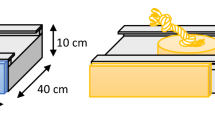Abstract
This experiment investigated whether domestic pigs can remember the locations of food sites of different relative value, and how a restricted retrieval choice affects their foraging behaviour. Nine juvenile female pigs were trained to relocate two food sites out of a possible eight in a spatial memory task. The two baited sites contained different amounts of food and an obstacle was added to the smaller amount to increase handling time. On each trial, a pig searched for the two baited sites (search visit). Once it had found and eaten the bait, it returned for a second (relocation) visit, in which the two same sites were baited. Baited sites were changed between trials. All subjects learnt the task. When allowed to retrieve both baits, the subjects showed no preference for retrieving a particular one first (experiment 1). When they were allowed to retrieve only one bait, a significant overall preference for retrieving the larger amount emerged across subjects (experiment 2). To test whether this preference reflected an avoidance of the obstacle with the smaller bait, 15 choice-restricted control trials were conducted. In control trials obstacles were present with both baits. Pigs continued to retrieve the larger bait, indicating they had discriminated between the two food sites on the basis of quantity or profitability and adjusted their behaviour accordingly when the relocation choice was restricted. This suggests for the first time that domestic pigs have the ability to discriminate between food sites of different relative value and to remember their respective locations.

Similar content being viewed by others
References
Barta A, Giraldeau LA (1998) The effect of dominance hierarchy on the use of alternative foraging tactics: a phenotype-limited producer–scrounger game. Behav Ecol Sociobiol 42:217–223
Budiansky S (1994) A special relationship: the coevolution of human beings and domesticated animals. J Am Vet Med Assoc 204:365–368
Clayton NS, Dickinson A (1998) Episodic-like memory during cache recovery by scrub jays. Nature 395:272–274
Clayton NS, Dickinson A (1999) Memory for the content of caches by scrub jays Aphelocoma coerulescens. J Exp Psychol Anim Behav Process 25:82–91
Clayton NS, Griffiths DP, Emery NJ, Dickinson A (2001) Elements of episodic-like memory in animals. Philos Trans R Soc Lond B 256:1483–1491
Done E, Wheatley S, Mendl M (1996) Feeding pigs: a preliminary study of the distribution of individuals around depleting resources. Appl Anim Behav Sci 47:255–262
Gustafsson M, Jensen P, de Jonge FH, Schuurman T (1999) Domestication effects on foraging strategies in pigs (Sus scrofa). Appl Anim Behav Sci 62:305–317
Hale EB (1962) The behaviour of domestic animals. Baillière, Tindall and Cox, London, pp 21–53
Held S, Mendl M, Devereux C, Byrne RW (2000) Social tactics of pigs in a competitive foraging task: the ‘Informed Forager’ paradigm. Anim Behav 59:569–576
Held S, Mendl M, Devereux C, Byrne RW (2001) Behaviour of domestic pigs in a visual perspective taking task. Behaviour 138:1337–1354
Held S, Mendl M, Devereux C, Byrne RW (2002) Foraging pigs alter their behaviour in response to exploitation. Anim Behav 64:157–166
Janeau G, Spitz F (1995) Daily selection of habitat in wild boar, Sus scrofa. J Zool 237:423–434
Kagel JH, Green L, Caraco T (1986) When foragers discount the future: constraint or adaptation? Anim Behav 34:271–283
Kamil AC, Balda RP (1990) Differential memory for cache sites by Clark’s nutcrackers (Nucifraga columbiana). J Exp Psychol Anim Behav Process 16:162–168
Krebs JR, Kacelnik A (1991) Decision-making. In: Krebs JR, Davies NB (eds) Behavioural ecology. An evolutionary approach. Blackwell, Oxford, pp 105–136
Krosniunas EH (1979) Social facilitation and foraging behavior of the feral pig, Sus scrofa, on Santa Cruz Island, California. MA thesis, University of California, Davis, Calif.
Kyriazakis I, Emmans GC, Taylor AJ (1993) A note on the diets selected by boars given a choice between two foods of different protein concentrations from 44 to 103 kg live weight. Anim Prod 56:151–154
Laughlin K, Mendl M (2000) Pigs shift too: foraging strategies and spatial memory in the domestic pig. Anim Behav 60:403–410
Laughlin K, Huck M, Mendl M (1999) Disturbance effects of environmental stimuli on pig spatial memory. Appl Anim Behav Sci 64:169–180
Meat and Livestock Commission (1997) Pig yearbook. Meat and Livestock commission. Bletchley, UK
Mendl M, Laughlin K, Hitchcock D (1997) Pigs in space: spatial memory and its susceptibility to interference. Anim Behav 54:1491–1508
Noldus (1995) The observer, base package for Windows reference manual version 3.0. Noldus Information Technology, Wageningen, The Netherlands
Parker GA (1984) Evolutionary stable strategies. In: Krebs JR, Davies NB (eds) Behavioural ecology: an evolutionary approach, 2nd edn. Blackwell, Oxford, pp 30–61
Pratt WE, Mizumori SJY (2001) Neurons in rat medial prefrontal cortex show anticipatory rate changes to predictable differential rewards in a spatial memory task. Behav Brain Res 123:165–183
Price EO (1984) Behavioural aspects of animal domestication. Q Rev Biol 59:1–32
Shettleworth SJ (1998) Cognition, evolution and behavior. Oxford University Press, Oxford
Sokal RR, Rohlf FJ (1995) Biometry: the principles and practice of statistics in biological research, 3rd edn. Freeman, New York
Spitz F, Valet G, Cousse S, Mann CS, Janeau G (1994) Nutritional strategies of free-ranging pigs: appearance and reality. Proc 45th Annu Meet EAAP, Edinburgh
Stephens DW, Krebs JR (1986) Foraging theory: monographs in behaviour and ecology. Princeton University Press, Princeton, N.J.
Tillé Y, Newman JA, Healy SD (1996) New tests for departures from random behaviour in spatial memory experiments. Anim Learn Behav 24:327–340
Acknowledgements
We are grateful to Tina Leeb and Poppy Statham for their help with data collecting, and three anonymous referees for their helpful comments. The study was funded by grants from the Biology and Biotechnology Research Council of the UK and The British Council in Austria. Research was conducted in compliance UK Home Office Animal Procedures regulations.
Author information
Authors and Affiliations
Corresponding author
Rights and permissions
About this article
Cite this article
Held, S., Baumgartner, J., KilBride, A. et al. Foraging behaviour in domestic pigs (Sus scrofa): remembering and prioritizing food sites of different value. Anim Cogn 8, 114–121 (2005). https://doi.org/10.1007/s10071-004-0242-y
Received:
Revised:
Accepted:
Published:
Issue Date:
DOI: https://doi.org/10.1007/s10071-004-0242-y




